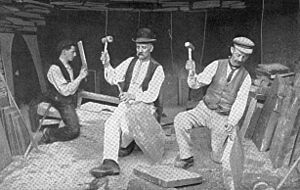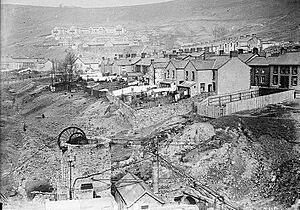Economic history of Wales facts for kids
The Welsh economy has changed a lot since the 1700s. Before then, it mostly relied on farming. Later, during the Industrial Revolution, mining became super important. Wales was once the world's biggest producer of slate. Its large coalfields also transformed many parts of the country. In the late 1900s, Wales saw a shift away from heavy industries. Now, its economy is mostly based on services.
Contents
Wales' Economy in the 1700s
Before the mid-1700s, Wales' economy grew slowly. This was because it was far from big cities. It also had many mountains, poor roads, and few people. Trade was strongest in small towns along the coast. These towns often traded with cities like Bristol or Liverpool.
Another important way of trading was through drovers. These people moved cattle from Mid Wales along special drover roads. They sold the cattle in England, even as far as London. Drovers even helped start the first banks in Wales. One example was Banc Y Ddafad Ddu ("Black Sheep Bank") in Aberystwyth.
From the mid-1700s, Wales' rich minerals helped its industries grow. New ideas and money from England also played a part. Using coke to melt iron made the South Wales Valleys a perfect spot for industry. This was during the Industrial Revolution. Demand for metals and coal grew a lot. This was first due to wars, then later because of steamships and railways.
The northern part of the South Wales Coalfield, near Merthyr, became Britain's top iron-making area. This happened in the late 1700s. The southwest part, around Swansea, became key for making other metals and tinplate. These metal industries needed more and more coal. At first, coal was mainly mined for this purpose. But by the mid-1800s, coal mining for sale really took off. This became the most important industry in the region. It completely changed the economy and way of life in the South Wales Valleys.
Wales' Economy in the 1800s
The slate industry in Wales was smaller than coal. Yet, it became the world's biggest supplier of slate in the 1800s. It also left a lasting mark on the landscape of North Wales. In the 1890s, at its peak, there were dozens of quarries. About 15,000 men worked in them. However, the industry faced ups and downs with building trends. Most workers came from Welsh-speaking areas. Because of this, one historian called slate quarrying "the most Welsh of Welsh industries."
Wales' Economy in the 1900s

Wales' economy grew fast in the early 1900s. But by the 1920s, problems appeared. Wales relied too much on older, heavy industries. Other parts of England were growing with newer, lighter industries. Even during its best times, Wales' economy was narrow. It depended on digging up natural resources, which needed many workers.
The Welsh export economy collapsed during the recession between the World Wars. This was due to countries protecting their own goods. Also, new competitors appeared overseas. As global trade changed, joblessness in the South Wales Valleys soared. During the early 1930s, it reached very high levels. For example, it was 59% in Merthyr and 76% in Pontypridd. This happened even though 400,000 people left the region between 1921 and 1939.
After World War II, the steel and tinplate industries changed. They moved to fewer, larger sites. Examples include new factories at Port Talbot and Llanwern. The National Coal Board, started in 1947, tried to update Welsh coal mines. But the number of mines in South Wales dropped a lot. There were 115 in 1953, producing 21 million tons. By 1981, there were only 34, producing 7.7 million tons.
Pembrokeshire and Swansea Bay became centers for the oil and gas industry. New light industries also came to Wales. From the 1970s, Wales attracted a lot of money from foreign companies. But many new factories built by foreign firms offered low-wage, low-skill jobs. In 1971, Sir Julian Hodge started the Commercial Bank of Wales. This bank was later taken over by another company in 2002.
In the decades after the war, more people started working in service jobs. By the 1980s, 60% of jobs were in this sector. Many of these jobs were held by women. More government offices moved to Cardiff. This created more public sector jobs. For example, the Royal Mint moved to Llantrisant. Companies House moved to Cardiff. The Driver and Vehicle Licensing Centre moved to Swansea.
From the 1970s, the steel industry shrank. Factories in Ebbw Vale, Shotton, and East Moors in Cardiff closed. Other places had layoffs. The early 1980s recession hit Wales harder than other parts of the UK. Between 1979 and 1982, Wales lost 130,000 jobs. The number of people working fell to 62%. Recovery in Wales started later. These big changes left many older men, especially in the Valleys, without jobs.
Wales' Economy in the 2000s
Wales is not as rich as London, a major financial city. But in 2019, the World Bank said that Wales' GDP per person was better than 127 other countries. Over time, Wales' economic output and efficiency have grown similarly to the rest of the UK. What makes Wales different is that fewer people work compared to other parts of the UK.
Economic Indicators
Wales' Gross Value Added (GVA) shows how much value is added to goods and services. This is a way to measure the economy's size.


